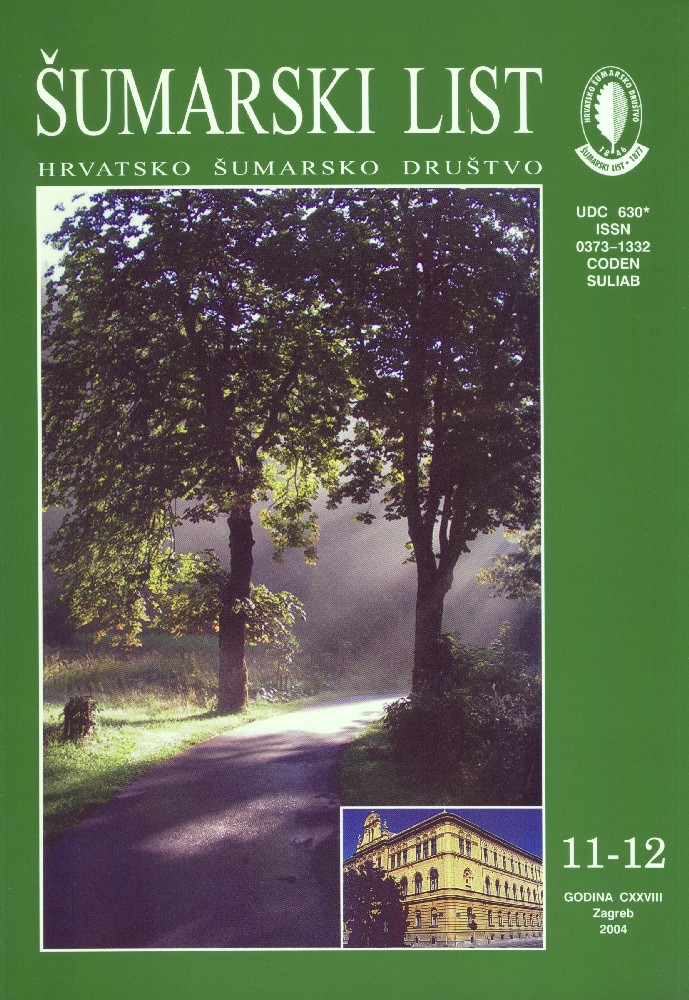
broj: 11-12/2004
pdf (33,1 MB) |
|
||||||||||||||
| IZVORNI ZNANSTVENI ČLANCI | ||
| Margaletić, J. | UDK 630* 451 + 136 (001) | |
| Population Dinamics of Woodland Rodents in Croatia pdf HR EN | 599 | |
| Beuk, D. | UDK 630* 156 + 903 (001) | |
| Losses Within the Big Game Stock in The Spačva Basin as Consequence of the Agression on the Republic of Croatia pdf HR EN | 609 | |
| Trinajstić, I. | UDK 630* 188 (001) | |
| Nomenclatural-Syntaxonomic Analysis of Silver Birch (Betula pendula Roth) Forests in Croatia pdf HR EN | 627 | |
| Summary: The silver birch – Betula pendula Roth is a typical pioneer species which in the progressive succession process on carbonate-free or decalcified carbonate soils is the first to conquer grasslands after mowing and grazing have been abandoned. As the first stage the ass. Pteridio-Betuletum is developed, and afterwards in further succession process the development of the ass. Populo tremulae-Betuletum occurs.During the vegetation mapping in Gorski Gotar, attention was attracted by the birch – Betula pendula stands in the composition of which the species Pteridium aquilinum was distinguished. This group has been designated by Trinajstić and Šugar as the ass. Pteridio-Betuletum. During mapping, the said stands were not analyzed in detail syntaxonomically, and therefore they remained “nomen solum”. It was only by Rauš and Matić (1994) that the ass. Pteridio-Betuletum was presented also by the relevés. Similarly Glišić (1950) was the first who published the binomial “Populeto-Betuletum” but without an adequate presentation of its floristic composition by means of any quantitative relations between individual species of the floristic composition, so this binomial remained “nomen nudum”. The floristic composition of silver birch forests is given in Table 1, on the basis of 8 representative relevés. Of them, the records 1-3 represent the ass. Pteridio-Betuletum, and the records 4-8 the ass. Populo tremulae-Betuletum. As the characteristic species of the ass. Pteridio-Betuletum it is designated Pteridium aquilinum, which in the floristic composition is present with a high level of covering. As the characteristic species of the ass. Populo tremulae-Betuletum it is designated Populus tremula, which is present in the tree and shrub layer as well as in the herb layer. The characteristic species of the alliance Quercion robori-petreae, the order Quercetalia robori-petreae and the class Quercetea robori-petreae are present relatively well. Distinguished by their absolute domination are Betula pendula and Quercus petraea in the tree layer, and Juniperus communis in the shrub layer. The herb layer is relatively poorly developed, especially within the ass. Pteridio-Betuletum, since due to the dominance of brake ferns just a small number of species has the conditions for survival. The companion species are very numerous. However, only a fairly small number of them achieve a higher level of permanency, the others being present in a few or in one record only. This suggests the idea that the birch stands are very heterogeneous floristically, while the elements of the natural, potentially forest cover indicate the progressive succession toward the development of the acidophilous sessile oak forests, namely acidophiolus beech forests. It should be pointed out that a sharp floristic boundary between the said birch forest associations does not exist, and therefore the records 3 and 4 can be considered as a transition between the ass. Pteridio-Betuletum and Populo tremulae-Betuletum, regardless of the areas and floristically analyzed stands involved. | ||
| Šporčić, M., Martinić, I. | UDK 630* 303 + 308 (001) | |
| Forest Contractors in Croatia pdf HR EN | 633 | |
| Ballian, D. | UDK 630* 165 (001) | |
| Microsatellite DNA Variability of Populations of Wild Cherry (Prunus Avium L.) from Central Bosnia pdf HR EN | 649 | |
| Poršinsky, T., Krpan, A. P. B., Stankić, I. | UDK 630* 363 (001) | |
| Efficiency of Mechanical Felling and Processing in Soft and Hardwood Broadleaved Stands – Part 4: Environmental Suitability of Mechanical Felling in Natural Stands pdf HR EN | 655 | |
| Zečić, Ž., Krpan, A. P. B., Stankić, B. | UDK 630* 375 (001) | |
| Skidding of Roundwood by Tractor Timberjack 240 C from Regeneration Felling in Condition of Forest Office Velika Pisanica pdf HR EN | 671 | |
| PREGLEDNI ČLANCI | ||
| Rubin, G. | UDK 630* 652 | |
| Evaluations of Forests – Practical Access pdf HR EN | 679 | |
| Gračan, J., Kajba, D., Perić, S., Idžojtić, M., Ivanković, M., Marjanović, H. | UDK 630* 165 | |
| Euforgen Forest Genetic Resources Programme Fourth Euforgen Steering Committee Meeting pdf HR EN | 689 | |


